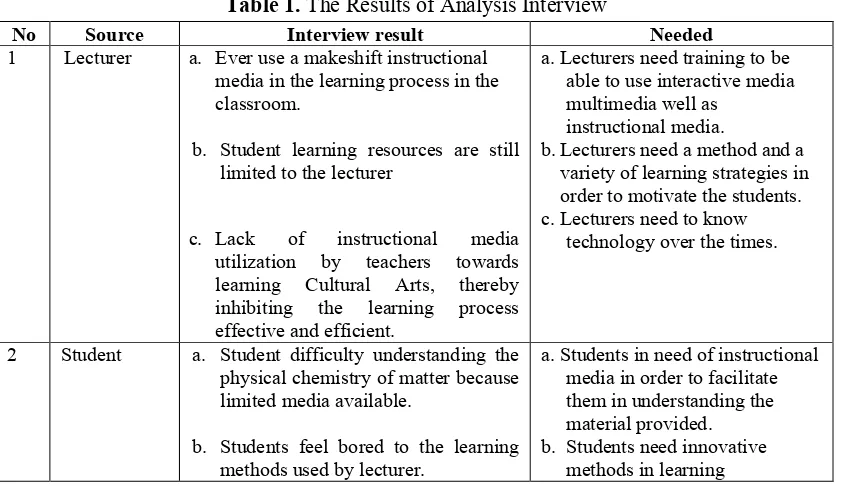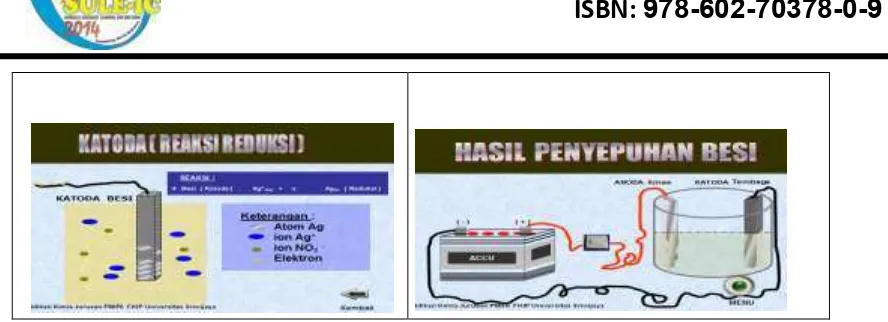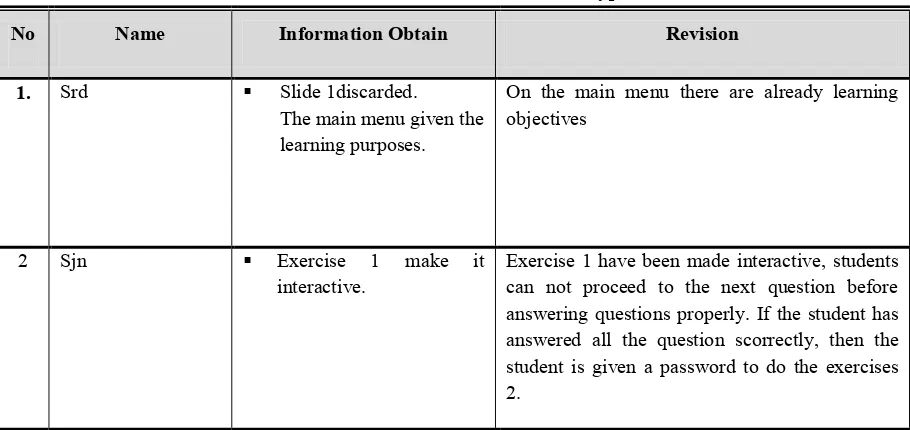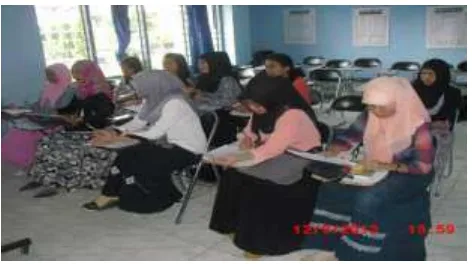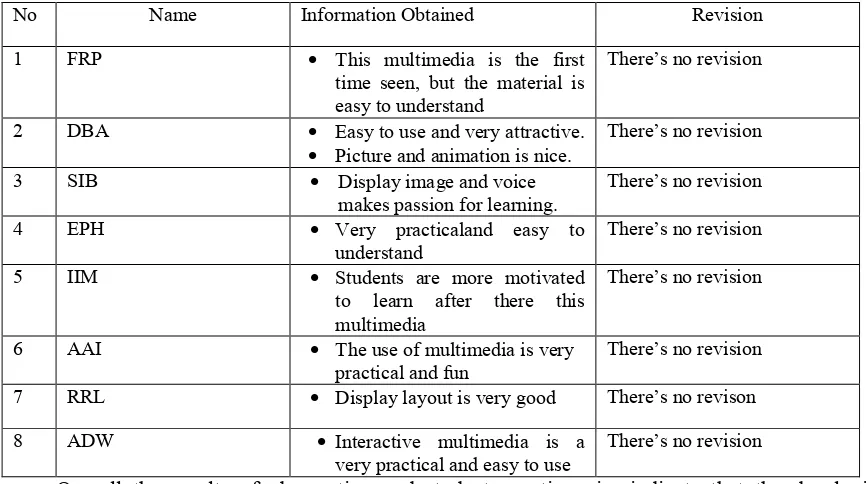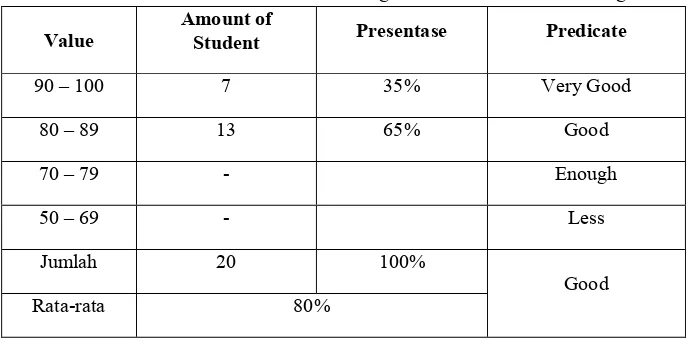This paper has been presented at Sriwijaya University Learning and Education-International Conference 2014. Faculty of Teacher Training and Education, Sriwijaya University, Palembang, May 16—18, 2014.
C3-516
Faculty of Teacher Trainer and Education of Sriwijaya University
Jl. Raya Palembang-Prabumulih KM 32 Indralaya Ogan Ilir
E-mail: [email protected]
Abstract
The objective of this study was to produce intractional animation-media with based PowerPoint which where valid and practice, so that it could improve the student learning outcomes in the chemical physics, subject especially the electrochemical cell. The research is the development research of Akker product development model which consists of analisys step, desigh, and evaluation. The evaluation methode used the formative evalution by Tessmer. The subject in research is the eighteen year old student of Chemistry Education of FKIP Unsri Palembang in the 2013rd. The data collection used walk through, observation, questionnaires, and test. The technical data analysis used observation data which analysis by giving score
to each descriptor and learning category’s activities, questionnairies data which Likert-Scale, the test data used test analysis results, and interview data dan walk through were analysis descriptively. Base on the research results, it could be concluded that intractional animation-media in chemistry education on the subject of the electrochemical cell has been developed to meet valid criteria and practicality to give potencial effects on the results of learning student of the eighteen year old on the electrochemical cell of chemical physics in the year of 2013 in Chemical Education of FKIP Unsri Palembang. The evidence of the results of the experts validity results suggested the intractional animation-media has been very valid especially for the subject of the electrochemical cell with average 4,85. From one-to-one evaluation and small group evaluation has been known that the use of the intractional animation-media for the subjects of the electrochemical cell was practical to use. From the stage of field test it was knows that the average
student’s score on the pre-test of 31,85 and the pos-test of 79,85 that meant there was an increase of 48,00. The average mastery learning 90%. Therefore, the researchers suggest the leacture to use this the intractional animation-media in the chemistry lesson on the subject of the electrochemical cell and conduct further research to get better product of the intractional animation-media.
Key words: intractional animation-media, electrochemical cell
INTRODUCTION
Learning process in college is properly base on students abillity, interest, utility, and their necessary. The aim is develop of learning skills, ability to free study, self-supporting, and to solve a problem. Lecture in every learning process must be using approach, strategy, and methode that can be able to student understand the learning material more easy. In adiition lecture must be able to motivating the students. The Succes of learning process is affected by competence of lecture to manage learning process (Suryosubroto, 2009). The development of Information technology is rapidly, especially internet, enable to develop information service that better in education. Usage IT in education is to support operational of education, so information services that better for students is available.
This paper has been presented at Sriwijaya University Learning and Education-International Conference 2014. Faculty of Teacher Training and Education, Sriwijaya University, Palembang, May 16—18, 2014.
C3-517
human to learning faster. Thus, besides as half part of daily life, information dan communication technology can use to revitalitation learning process and at the end can be adapted studend with environment and the world of work. According to interviews result from lecture in Chemistry Education in FKIP Unsri, found if learning outcomes of students in Physicalchemistry is still low, there are many C grades. Students tend to be passive in learning and considers Physical Chemistry is abstract so that students are not motivated in Physical Chemistry learning, and difficult to understand. Pradana (2011) do development research of animation media using Power Point in biology. Judgment expert toward quality of teaching media based on characteristics of the media in multimedia a the percentage of advisability is 89 %. The result from expert for learning materials based on the competence standard in food trials is 91%. The results in test which is divided into two aspects: the material and media, the overall results gets a percentage of advisability is 88.87%.
Theutilization of technological developments can be used to improve the learning outcomes of learning chemistry, special in Chemical Physics and motivated students in lesson. Production of learning media that use animation program with powerpoint is expected to improve student learning outcomes and motivation. Based on the background of the foregoing problems the problem in this research is : how to develop animation media of electrochemistry cell based Power Point that valid and practice ? And how the effectiveness animation media of electrochemistry cell based on Power Point to ward students outcomes in Chemistry Education of FKIP Sriwijaya University ?
THEORETICAL BACKGROUND The Nature of Learning
One of skills that lecturers must have , as one of the elements of educators in order be able to carry out his professional duties is to understand how students learn and how to organize the learning process that can develop skills and character of students, as well as understanding how students learn (Winataputra , et al , 2007: 1)
Learning is a assimilating process and connecting experience or materials that have been studied, so its definition wil developed (Dahar , 2000:11). Changing by learning process is progresif and acummulative, leading to perfectionfor example from not able to be able, from not understanding became understood, covers both aspects of knowledge (cognitive domain), the affective aspect (affective domain) and psychomotor aspects (psychomotor domains ) . Learning is a process of the work do by the individual to acquire a new behavior change as a whole as a result of the individual's own experience in the interaction with the environment .
The learning process can be devided to three phases namely (1) the information, ie : in every lesson we get some information, there are add to existing knowledge, there are refined and deepened, there is information that is contrary to what is already known, for example, there is no energy is lost. (2) transformation, namely ; Information that must be analyzed, modified or transformed into a form that is more abstract or conceptual order to be used for things that are more extensive. (3) evaluation, which is assesment about Which is acquired knowledge and the transformation can be used to understand other symptoms, Bruner (in Nasution 2009: 9 ).
Learning Outcomes
This paper has been presented at Sriwijaya University Learning and Education-International Conference 2014. Faculty of Teacher Training and Education, Sriwijaya University, Palembang, May 16—18, 2014.
C3-518
learning outcomes. Learning outcomes are basically the result of a learning process. Learning outcomes are the skills possessed by students after he received a learning experience ( Sudjana , 2005:22 ).
Learning outcomes is a activity of mental and psychic that held in an interactive environment to produce changes in knowledge, understanding, skills, attitudes values. Learningoutcomes is a culmination of learning process, which is the result of an interaction actsof learning and acts of teaching usually is show astest scores given by the lecturer (Dimyati and Mujiono , 2003: 3).
So it can be concluded that the learning outcome is a measure of the success the students to understanding the lessons given by lecturers from the value of the test that can be given in numbers or scores. Which is an indication that a learning process is deemed successful, namely: (1) absorption to the teaching materials is high achievement, both individually and in groups, (2) Conduct outlined in the learning objectives have been achieved by students (Djamarah , 2002 : 120).
Based on the opinion above, it can be affirmed that one of functions student’s learning outcomes is student can achieve maximum agreeable with their capacity, as well as students can cope a wide range difficulties of learning experienced. According Dimyati and Mudjiono, learning outcomes are things that can be viewed from two sides of that is side of thestudents and lecture. In terms of student learning outcomes is the level of mental development better than it was before study.
Power Point Application Program
Power Point is one of the software programs used to create animations, presentations, animated lessons and films. Animation product that produce from powerpoint is animation of movie files. The resulting can be either graphics or text. The graph in question here is a vector-based graphics. Additionally PowerPointhas the ability to import sound files, video and image files from other applications.Excess PowerPoint consideration from other animation software, is : (1) The existence of Action Script, Action Script is a scripting language which of Power Point that used to make a animation. Action Script is required to give the effect of motion in the animation. (2) Can be used to communicate with PowerPointprograms.
Kemp (1975), said the characteristics of learning media is basic to selection its according with a particular learning situation. He also said, that knowledge about the specific advantages and disadvantages which are owned by a media, is something that is very important to be known by educators. Two education experts from France Gagul and Raise, argues; in determining the selection of a specific medium to deliver the message generally, any some connection to learning media. In other words delivering strategy by general people would be applicable also in the world of education. The other opinion said abaout procedure to selecting communication media proposed by Anderson. According to him, the prosedur to selection media starts from the question ; Is the media intended for physical or cognitive skills ? These questions will determine what kind of instructional media will be made.
Development Research
This paper has been presented at Sriwijaya University Learning and Education-International Conference 2014. Faculty of Teacher Training and Education, Sriwijaya University, Palembang, May 16—18, 2014.
C3-519
development, it means that the collection, processing, analysis, and presentation of data are carried out systematically and objectively, along with activities to develop product to solve a problem are faced.
Sugiyono (2011) also states that development research is the ofresearch methods that used to produce a particular product and test the effectiveness of these products. Generally, deveopment researh begins with the study in small scale research its can be in the form of data collection and want to find a solution (Sumarno , 2012).
Some steps in the research & development (Akker, 1999) is : (1) Preliminary diagnostic (preliminary inverstigation), (2) a preliminary diagnostic systematic and intensive from the problems, including: a) review of the literature, b) consulting with experts, c) analysis of the availability of the example for purposes related, and d) case studies of common practice for detailing needs, (3) theoretical embedding, a more systematic effort is made to apply basic knowledge in addressing theoretical rationale for the design choices, (4) empirical testing.
METHOD
The approach used in this research is the development of research proposed by Akker (1997), the development reasearch includes three criteria for measuring the quality of a product, validity, practicality and effectiveness. According to Akker and Plomp (1999) development research is a reasearch approaches that have two objectives, namely: a) the development of prototypical products (curriculum document and materials), Including emperical evidence of their quality, b) generating methodological directions for the design and evaluation of such products.
The Learning development model is divided into four steps, namely: analysis step, this step is the first step of development reasearch. In this case the analysis of the learning outcomes and student’s motivation in chemical physics courses in Chemistry Faculty of Teacher Education Program, Sriwijaya University. Design step, in this step, the design is make an electrochemical cell animation design with powerpoint, evaluation step and revision step.
Evaluation step refer to Tessemer’s formative evaluation respectively are as follows: Self Evalution, Expert review and One-to-One Evalution, Content, construct and lay-out validated by Expert in manufacturing design, content, and language. Beside that, validation data also uses one-to-one evalution is techniques that utilize students to see the development of an electrochemical cell animation using powerpoint that are used then asked student to comment the media. Small group, the result of revision from the expert and the difficulties experienced by students when test materials using the electrochemical cell animation development power point in first prototype used as a basis for revising the electrochemical cell animation which is called prototype two. Then the results are tested on a small group which consists of 9 students in third grade who have different capabilities in view of the results of studying chemistry in the first semester, and field Test, which Items have been revised based on suggestions from experts and the results of tests on small group use on the subject of research in the field test, and revision products.
This paper has been presented at Sriwijaya University Learning and Education-International Conference 2014. Faculty of Teacher Training and Education, Sriwijaya University, Palembang, May 16—18, 2014.
C3-520 RESULT AND DISCUSSION
In this research, there are four steps being taken by Akker development model, namely analysis step, design step, evaluation and revision step.
Analysis Step
Analysis step, the planning step is first of all the researchers did was needs analysis which includes interviews with peers, analyze standards and basic competencies, as well as interview with some students. Furthermore assign formulated objectives include determining standard competence and basic competence, assign indicators, and rearrange the purpose of lectures and materials will be developed. The results of the analysis at the planning stage can be seen in Table 11 as follows:
1) Requirement analysis, needs analysis conducted interviews, the interview data as in Table 1.
Table 1. The Results of Analysis Interview
No Source Interview result Needed
1 Lecturer a. Ever use a makeshift instructional media in the learning process in the classroom.
b. Student learning resources are still limited to the lecturer
c. Lack of instructional media utilization by teachers towards learning Cultural Arts, thereby inhibiting the learning process effective and efficient.
a. Lecturers need training to be able to use interactive media multimedia well as
instructional media.
b.Lecturers need a method and a variety of learning strategies in order to motivate the students. c. Lecturers need to know
technology over the times.
This paper has been presented at Sriwijaya University Learning and Education-International Conference 2014. Faculty of Teacher Training and Education, Sriwijaya University, Palembang, May 16—18, 2014.
C3-521 Design Step
In this stage, conducted the beginning product design to be developed. This stage contains the designation that includes blueprint/design materials, outline media programs, flowcharts, storyboards, and design evaluation tool. Aseach ofthesestages, namely:
1). Blueprint / creativeplan. Before making a storyboard, researchers planto first electrolysiscell materials. Plangrafted material must comply with the Standard Competency: understand the oxidation reduction reactions and electrochemicalcells syllabus analysis results can be seen in table 2 below:
Table.2. Syllabic Analysis Result
Competence Standard Basic Competence Indicator
1. Understanding Writing the redox reaction in metal
refining
Description Topic : This program will discuss about Redox Reaction in plating and metal refining process
Competence Standard : Understanding oxidation-reduction reaction and electrochemistry cell.
This paper has been presented at Sriwijaya University Learning and Education-International Conference 2014. Faculty of Teacher Training and Education, Sriwijaya University, Palembang, May 16—18, 2014.
C3-522 a. Opening
This multimedia begins with opening animated program that presented by video about
electrolysis process and the task that must discuss in group, the point is to be able to attract the student’s attention
b. Title Page
Page 1 title is given by displaying title text “Electrolysis Cell” and “Next and Back and menu button to continue” text. Title text “Electrolysis Cell” aims to providing the information to students about what they will be studied in multimedia, so the students focusing their knowledge and experience on the Electrolysis Cell material.
c. Home Page
The menus that located on the home page are curriculum which contains basic competence and indicator, theoretical concept, copper plating, metal plating, and exercises. Students can choose the menu according to what will be studied in advance.
d. Competence
In this section presents the competence standard, basic competence, and indicator from interactive animation media is presented
e. Learning Materials
Learning material presented by using animation information of text and picture. The use ofappropriate colorsserves toattractandfocus thestudent's attention, while picture and animation aimedto increasestudentinterest and understandingof thematerial presented. In addition, students canwork onmaterialcompletedexercises. These exercisesaim totest thecompetence/students' understanding ofthe material being studied.
f. Evaluation
Evaluation is given for testing students competence after doing learning activities using interactive animation media on electrolysis cell material.
g. Closing
In this section there is “thank you have followed today’s lesson” text. That text is appreciation form research for the students because they already used well the animation media for
electrolysis cell.
3) Planning the evaluation, For this stage evaluation tool is planned such as like the expert validation survey of material, media, and instructional design. Each evaluation tool that already validated by experts can be seen in appendix.
After the revision and stated require for test trial, next step is design the interactive animation media in to computer based form. After all material collected to completed the interactive animation media such as animation and picture, next step is programming that is linking all materials and accordance with the script.
Production Result
This paper has been presented at Sriwijaya University Learning and Education-International Conference 2014. Faculty of Teacher Training and Education, Sriwijaya University, Palembang, May 16—18, 2014.
C3-523
This paper has been presented at Sriwijaya University Learning and Education-International Conference 2014. Faculty of Teacher Training and Education, Sriwijaya University, Palembang, May 16—18, 2014.
C3-524
Figure 1. First prototype
Figure 1above is the first proto type designs that represent multiple views of the electrolysiscell materials that existon the Power Point program in interactive media animation developed by researchers
Evaluation Step
Results of an interactive animated media learning basic competencies describe the process that occurs in the electrolysiscell has been designed and manufactured to produce aprototype1. Then followed by expert review step consisting of matter experts, media, and instructional design. Furthermore, after the expert review, interactive animated media product material electrolysis cells tested one-to-one evaluation to 5 students where five students have different abilities, namely high, medium, and low. After a one-to-one evaluation then followed by small group evaluation. This is done to determine the validity and practicality of the developed interactive animated media . Furthermore, field tests is the subject of a trial in which the actual research results from a valid and practical prototype will be tested in order to determine the effectiveness of the student learning outcomes .
a) Result of Expert Review
This paper has been presented at Sriwijaya University Learning and Education-International Conference 2014. Faculty of Teacher Training and Education, Sriwijaya University, Palembang, May 16—18, 2014.
C3-525
Table 4 Result of The Validation Prototype 1
Based on the resultsof the validation test experts, it can be concluded that interactive learning media (Prototype 1) developed already quite good although there are some parts that need to be repaired. By doing the improvements, the initial product is found to have a valid and can be used by students.
b) Evaluation Result One-to-One
At this stage prototype 1tested on one to one, prototype 1 tested on three students of FKIP Chemistry who have the ability high, medium and low. Participants students using interactive animation media, after it conducted interview swith student stoprovi decomments or suggestions on the media that has developed an interactive animation. The stages of this trial was conducted in order to determine the practicality of prototype 2. The process of testingone to one can be seen inthistable 5 below:
Table 5. Comment Result One to one
No. Name Information Obtain Revision
1 FRP
(High Abillity)
Given this medium I find it easier to learn, learning electrolysiscells become more interesting and easy to understand.
The material is very clear.
The language used is also easy to understand
There’s no revison
No Name Information Obtain Revision
1. Srd Slide 1discarded. The main menu given the learning purposes.
On the main menu there are already learning objectives
2 Sjn Exercise 1 make it
interactive.
This paper has been presented at Sriwijaya University Learning and Education-International Conference 2014. Faculty of Teacher Training and Education, Sriwijaya University, Palembang, May 16—18, 2014.
C3-526
2 SIB
(Medium Abillity)
Image display is nice and makes meinterested in learning electrolysicells,
The existence of the video at the beginning made me want to learn how events
There’s no revison
3 EPH
(Low Abillity)
This multimedia is very fun,I do not feel tired any more to learn about the electrochemicalcell.
There’s no revison
From the table above, students were asked to comment on the use of interactive media. Based on the results of one-to-one evaluation there are still some short comings / weaknessesso that the firstprototype should fixed first. The firstprototype has been revised, here in after referred to as these condprototype. Having revised the first prototypeeroduct developed conclude practicaluse. These condprototype then performed evaluation stage on small group.
c) Evaluation Result Small Group
The results of expert review so fone-to-one used as the basis forrevising the prototype 2. To further investigate the practicality of interactive media developed, further evaluation of small groups totaling 10 students Chemistry FKIP Unsri.
The learning process is done by observation and administration of student activity questionnaire for students to ask for student feedback on the use of interactive media. The learning process that takes place can be seen in Figure 2 below:
Figure 2. Student Activities Small Group Stage
This paper has been presented at Sriwijaya University Learning and Education-International Conference 2014. Faculty of Teacher Training and Education, Sriwijaya University, Palembang, May 16—18, 2014.
C3-527
Table 6. Recapitulation Questionnaire Results Using Interactive Mediain Small Group Evaluation
Based on the estimates obtained from the averaged results of the student questionnaire to use interactive media learning basic competence electrolysiscell described in table 6 was 87.75% with a very practical category. In addition students were asked to fill a questionnaire, the students were also asked to give suggestions as improved interactive media researchers developed the interview by asking or are not structured to students. Some student comment scan be seen in Table7, the two men did not leave a comment.
Table. 7 Comment Result Small Group
No Name Information Obtained Revision
1 FRP This multimedia is the first
7 RRL Display layout is very good There’s no revison
8 ADW Interactive multimedia is a very practical and easy to use
There’s no revision
This paper has been presented at Sriwijaya University Learning and Education-International Conference 2014. Faculty of Teacher Training and Education, Sriwijaya University, Palembang, May 16—18, 2014.
C3-528
second prototype revision. Further more, this second prototype became the third prototype that will be used to study media field test stage.
d) Field Test
After known the validity and practicality of the products which developed through expert evaluation review, one to one and small group obtained a valid and practical prototypes 3, then conducted a field test. This step conducted to know the efectivity from prototypes 3 as a whole through observation and cognitive evaluation. At this prototypes 3, practicality do not tested anymore because at prototype 2 which developed, have fulfilled practically criteria. The test that conducted in this Prototype 3 only efectiveness test. This test is conducted in class semester 3 FKIP Kimia Unsri. The learning activities using interactive media learning basic competence electrolysis cell described two meetings. Learning which used, focused on students, lecturer only act as a facilitator. At a meeting, learning conducted observational study to determine the students' learning activities.
At the first meeting before discussing the subject matter begins with a pretest. Teachers give the pre-test about 10 questions to the students. Pretest was conducted to measure the extent of student ability or knowledge about basic learning competencies describe the electrolysis cell. Pretest results obtained 45% enough category, and 55% less category. After student working the pretest, lecturer describes the definition and function of the electrolysis cell.
Furthermore, at the end of the lesson students doing exercises that given by lecturer as many as 5 questions. Students are required to answer all the first questions correctly in order to working on the second excercise. After completing all the questions correctly students will get the password to proceed to second exercise. The result of learning activities at first meeting which conducted by students carried out increase by 80%, can be seen in the following table:
Table 8 Result of Student’s Learning Activities at First Meeting
Value
Amount of
Student Presentase Predicate
90 – 100 7 35% Very Good
80 – 89 13 65% Good
70 – 79 - Enough
50 – 69 - Less
Jumlah 20 100%
Good
Rata-rata 80%
This paper has been presented at Sriwijaya University Learning and Education-International Conference 2014. Faculty of Teacher Training and Education, Sriwijaya University, Palembang, May 16—18, 2014.
C3-529
Table.9 The Result of Student’s Learning at Second Meeting
Value Amount of
Student Presentase Predicate
90 – 100 8 40% Very Good
80 – 89 9 45% Good
70 – 79 3 15% Enough
50 – 69 - - Less
Total 20 100%
Good
Average 83%
Furthermore, after completing second exercises, students are given a post-test to measure the potential effects after using interactive multimedia. Comparison of the value percentage of the pretest and post-test can be seen in the following figure.
Figure3 Bar Chart Comparison Pretest and Post test Value
Based on the picture 3 above shows that the average value of the pretest were achieved by 60.5% of students with less category, while the student results achieved in the first and second meetings increased by 80% and 83% with a very good category. And post test results obtained 90% mean value with very good category. Seen from the comparison of the mean value of the pretest and post-test there was an increase of 29.5%. After analyzed using N-gain, the result very high namely above 0.7. Based on these results, it shows that the effectiveness of interactive multimedia has had effectiveness on student learning outcomes.
DISCUSSION
This Research is Development Research. The aim of this development research is producting an interactive learning media and basic competence described about electrolysis cell validly and practically. The procedures in the research development carried out by four steps based on Akker development model are analysis step, design step, evaluation step.
This paper has been presented at Sriwijaya University Learning and Education-International Conference 2014. Faculty of Teacher Training and Education, Sriwijaya University, Palembang, May 16—18, 2014.
C3-530
computer based design. Paper based design includes the preparation of blueprints / design materials, outline media programs ( GBPM ), flowcharts, and the script ( storyboard ) and evaluation tools.
Meanwhile, the design of computer-based programming include basic animation creation using power point. Furthermore , the products resulting from the production step is called the first prototype. To measure the validity, practicalities, and the effectiveness of its use , researchers conducted an evaluation that consists of expert evaluations (expert reviews) , the evaluation of one-on-one (one-on-one to one-on-one evaluation), evaluation of a small group (small group evaluation) and field test (field test) .
Initial steps of the researcher have done to test the validity and practicalities is an evaluation of the first prototype .The process of testing the validity and the practicalities of the use of interactive media to describe the basic learning competencies electrolysis cells was done by way of implementing expert review and one to one evaluation. Expert review the material in question is the expert, the instructional design expert, and media experts. In this first prototype material validation performed by Sin as a lecturer in Educational Studies Program Kimia FKIP Unsri.
Instructional design validation performed by a lecturer in Educational Technology Program PPS Sriwijaya University. Based on the results of the validation test (expert reviews) demonstrated the first prototype that has been relatively well designed and fit for using in learning though still no improvement on the content and view of the product. By therefore need to be revised to produce a second prototype based on suggestions from validator.of product that has already revised can be used to students.
Then the researchers conducted one-on-one evaluation tested on three students with different abilities in order to determine the response and comments to the learners an interactive multimedia learning basic competencies describe the electrolysis cell researcher developed . The experiment was carried out one by one in the class 3 semesters of Chemistry Faculty of Teacher Education Program Student Unsri using computers and student response sheets to use interactive media to describe the basic learning competencies electrolysis cells .Results obtained from several student comments can be concluded that the second prototype products designed already quite good and practical to use.
In addition it is also done on the practicalities of a small group with ten learners by conducting observations and student feedback questionnaire filling. After the event is done, then obtained a second comment that the product prototype is already better than the first prototype and the students are not so experienced problems in understanding and using the second prototype products related to both the navigation and understanding of the material. This shows that the prototype has been tested both validity and its practicalities with questionnaire data showed 87.75 % with very practical products that have proven validity and its practicalities.
This paper has been presented at Sriwijaya University Learning and Education-International Conference 2014. Faculty of Teacher Training and Education, Sriwijaya University, Palembang, May 16—18, 2014.
C3-531
obtained either category. Judging from the results obtained pretest average value of 60.5 % with less category . While the post test results obtained given the average value of 90 % with very good category. Comparison of the average value of the pretest and post-test showed significant differences. This is because the process of learning by using interactive media to encourage more active student understanding of the material and the ability of an electrolysis cell for the better .
CONCLUSION AND REMARK
Conclusion
a. Instructional media products developed electrolysis cell researchers have declared invalid after being validated by expert review (the experts), so that the instructional media products fit for use in an electrochemical cell chemistry physics lectures .
b. Instructional media products developed electrolysis cell researcher its practicalities proven otherwise, it is seen from the ease of student use of instructional media products in the electrolysis cell test one-on-one (one to one evaluation) and test groups (small group evaluation) .
c. Instructional media products developed electrolysis cells expressed researchers have raised the effectiveness of the student learning outcomes . This can be seen in the value of the post-test than pre-test of the value of student learning outcomes at the field test stage of evaluation
Remark
a. For faculty, are expected to use instructional media products of electrolysis cells as an alternative medium of learning , so as to facilitate the lecture in class .
b. For students, learning media products electrolysis cell is expected to train students for independent learning , increase student interest in studying the electrolysis cell and facilitate student understanding electrolysis cell competence .
REFERENCES
Ahmadi, I. (2012). Sel Volta, (online), http://imamahmadi.wordpress.com/, accessed on Mei 7th, 2013. Akker., J. (1999). Principles and Methods of Development Research. PadaJ. van den Akker, R.Branch,
K. Gustafson, Nieven, dan T. Plomp. (Eds). Design Approaches and Tools in Education and Training.1--14. Dortrech: Kluwer Academic Publishers.
Akker, J., et al. (2006). Educational Design Research. London and New York: Routledge.
Budiyanto. (2013). Pengertian dan Notasi Sel Elektrokimia, (Online), http://budisma.web.id/, accessed on Mei 7th, 2013.
Dahar, R.W. (2000). Teori-Teori Belajar. Jakarta: Erlangga.
Dimyati & Mujiono. (2003). Belajar dan Pembelajaran. Jakarta: Rineka Cipta.
Nasution, S. (2009). Berbagai Pendekatan dalam Proses Belajar & Mengajar. Jakarta: Bumi Aksara. Pangganti, E. (2012). Sel Elektrolisis, (Online), http://esdikimia.wordpress.com/, accessed on Mei 7th,
2013.
This paper has been presented at Sriwijaya University Learning and Education-International Conference 2014. Faculty of Teacher Training and Education, Sriwijaya University, Palembang, May 16—18, 2014.
C3-532
Slameto. (2003). Belajar dan faktor-faktor yang mempengaruhinya. Jakarta: Rineka Cipta. Sudjana. (2005). Penilaian Hasil Proses Belajar Mengajar. Bandung: PT Remaja Rosdakarya.
Sugiyono. (2011). Metode Penelitian Pendidikan: Pendekatan Kualitatif, Kuantitatif dan R&D. Bandung: Alfabeta.
Suhendar, A. Langkah-langkah penggunaan Vidio Camtasia,(Online). www.akipsuhendar.ac.cc, accessed on April 25th, 2013.
Surya, H., S. (2010). Perancangan Media Pembelajaran Menggambar Teknik Dasar Dengan Menggunakan Camtasia pada Peserta Didik kelas X Teknik bangunan SMK Negeri 2 Surakarta. Disertasi. Surakarta: Universitas Sebelas Maret.
Suryosubroto, B. (2009). Proses Belajar Mengajar di Kampus. Jakarta: Rineka Cipta.
Tessmer, M. (1998). Planning and Conducting Formative Evaluations. Philadelphia: Kogan Page. Winataputra, U., dkk. 2007. Teori Belajar dan Pembelajaran.. Jakarta: Universitas Terbuka.
